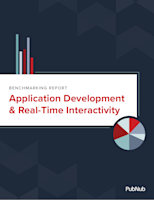Transforming Cross-Platform Experiences in Real Time With AI

Cross-platform experiences are now part and parcel of everyday life in recent years. Google Docs lets you get started on a draft on your desktop before switching to your mobile if needed. iCloud lets you upload photos using your mobile and open them on your laptop. Netflix lets you watch a show using different devices. Amazon will have your shopping cart ready and waiting, regardless of where you continue shopping.
Users can do all this because developers understand that people are no longer tied to their desks today. They are mobile (literally) and take work with them, making real-time access on different devices an absolute priority.
In this article, we'll explore why cross-platform experiences are synonymous with "real time" and how you can optimize user experiences with the help of artificial intelligence (AI).
Understanding cross-platform experiences and the power of real-time interactivity
People own multiple devices today—a Windows laptop, an Apple iPad, and an Android phone, for example—and cross-platform experiences ensure they can seamlessly move between devices.
Cross-platform experiences
A cross-platform experience refers to the user experience on different device types and operating systems.
People are accessing applications on multiple devices, switching between them as they please. For instance, they start a Slack conversation on their laptop and continue chatting on their smartphone while grabbing a coffee. For this experience to be seamless end-to-end, users shouldn’t feel like they're using a completely new app when they switch devices. Every experience should be a personalized experience.
This is the main tenet of a cross-platform experience: consistency across devices, letting users work according to their convenience instead of working around the technology. But a truly seamless cross-platform experience should also support real-time interactivity.
Real-time interactivity
Going back to the Slack example, if your messages take too long to update on your mobile device, the experience is no longer seamless. The application needs to update in real time to provide the ideal cross-platform experience.
Real-time interactivity or interaction is the ability of a system to provide an optimized response to an event as it happens. It allows applications like Slack to update information as it's generated, allowing users to respond from any device in real time. Real-time interactivity empowers businesses to employ informed decision-making and streamline their workflows using real-time data. Additionally, they can offer better user experiences by resolving requests immediately.
However, enabling real-time interactions can be challenging. Applications have to scale to support the increasing volume of data. This is why developers are increasingly using AI tools.
AI powers the next generation of real-time interactive experiences
AI can easily process and interpret large datasets to gather in-depth insights into user behavior, preferences, and future transactions. Developers can use various AI solutions to create real-time cross-platform experiences in their applications, such as:
Natural language processing (NLP) for real-time communication
NLP allows machines to understand and respond to human language by processing large volumes of text or audio data using advanced algorithms, statistical models, and linguistic rules.
It facilitates more natural, contextual conversations between humans and machines in real time. Virtual assistants like Siri and Alexa are great examples of how NLP can enable human-like interactions, allowing users to ask questions and make requests. At the same time, the AI models use context to provide the most relevant answers.
Another use of NLP is profanity filtering and translation, especially useful in live chat interactions where it’s almost impossible to monitor and filter text manually. PubNub enhances live audience engagement by offering real-time profanity filtering and translations for a more engaging live experience.
Machine learning (ML) for personalized real-time responses
ML uses complex algorithms and advanced analytics models to identify patterns in large datasets. It can be used to identify commonly asked questions by customers and train chatbots to respond to these queries more naturally. You can also enhance the chatbot’s capabilities by using machine learning with NLP to analyze customer intent in real time, helping to elevate the customer experience.
A great example of an application that uses machine learning and NLP to generate real-time responses is ChatGPT. Since it works on a public database, you can easily leverage ChatGPT to enable your chatbot to provide more contextual responses to customer queries, without the need for sensitive customer data.
PubNub lets you create real-time chat applications using its OpenAI Chat API, which uses your existing documentation to respond to user queries. It also personalizes responses using previous messages for more context.
How AI facilitates real-time interactivity in cross-platform experiences
AI can perform mundane tasks faster and more efficiently than humans, leaving us free to focus on other value-adding tasks.
Streaming data across platforms in real time
AI technology allows applications to quickly process large amounts of data across devices, no matter the coding languages used, by automatically converting data into formats other devices can interpret. AI also uses less bandwidth to facilitate communication between devices. This makes real-time data streaming between applications more seamless.
Cross-platform experience testing
Cross-platform testing uncovers issues affecting the user interface (UI), usability, consistency, and performance when applications run on different platforms, such as iOS, Windows, Android, etc.
AI and ML make testing processes faster and more reliable by removing human error from the equation. AI can generate and run test scripts, improve test analysis, and conduct routine checks. Meanwhile, machine learning can also provide business value by reducing costs and predicting possible errors and improvements using historical data.
Leveraging AI across platforms to enable exceptional user experiences
Cross-platform experiences are no longer just about consistency across devices. They're about providing consistency across devices in real time, for any use case. Luckily, AI solutions like machine learning and NLP can enable real-time cross-platform experiences more easily and seamlessly, such as responding to queries and engaging with live audiences.
PubNub offers a complete solution to integrate AI into your real-time applications, whether adding automation to existing apps or building interactive apps for the web, mobile, or IoT devices. Get in touch to learn more, or sign up for a free trial to explore how PubNub can bring real-time interactions to your cross-platform applications.


